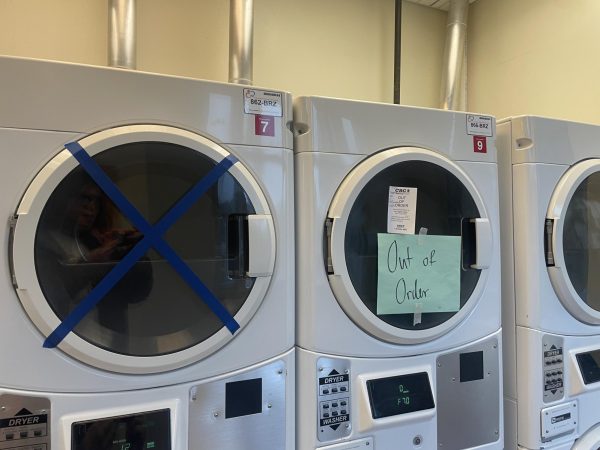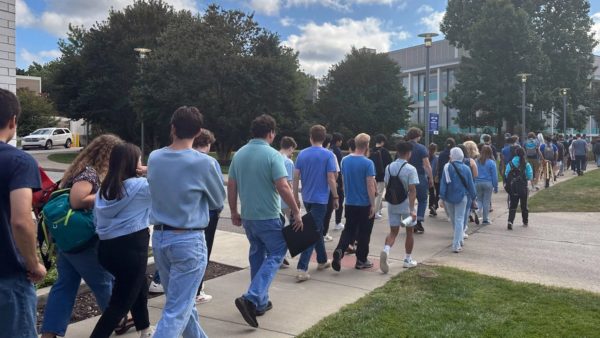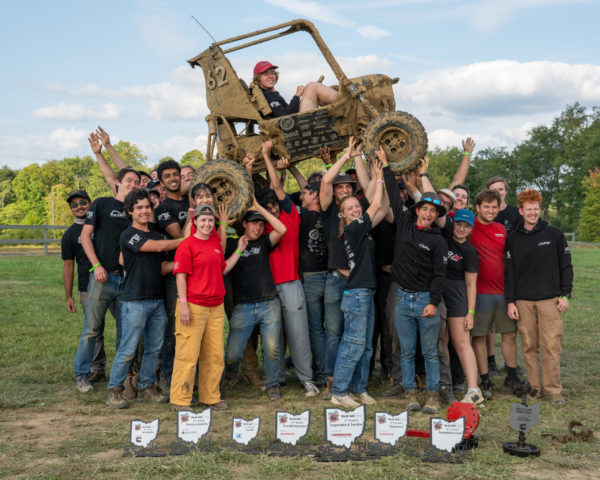Student entrepreneurs on quest to recover lost high altitude research balloon from middle of Lake Erie
April 1, 2014
UPDATE: April 3: 11:00 A.M.
Carbon Origins has been contacted by a marine salvaging company, but using that option would cost them $2,500-3,500, money that would be difficult for the group to raise. They’re still trying to look at other free options before having to spend several grand on a rescue attempt (since they’re still receiving radio data, which would be difficult to transmit underwater, Srirangarajan believes that capsule is fortunately floating). The group also now is looking to charter a helicopter that could tag the balloon, and even possibly pick it up, since there is a good chance that the capsule is currently sitting on an ice sheath, making recovery a little more difficult. On top of that, time is running out faster than expended; temperatures in the capsule are lower than what the group predicted, which is taxing the equipment’s heating and thus battery systems. -Kushagra Gupta, staff reporter
Third-year mechanical, aerospace and computer engineering triple major Amogha Srirangarajan didn’t have a fun April fools day.
His recent work is currently floating in the middle of Lake Erie, nearly twenty miles off shore, but he’s on a mission to get it back. The rescue won’t be easy. The clock is ticking, and he needs your help.
Srirangarajan is the founder of Carbon Origins, a CWRU-student led aerospace company aiming to send small payloads into suborbital space for pennies on the dollar.
The company launched a high altitude research balloon around 5:30 a.m. to test its new flight computer. The balloon hit an altitude of 120,000 feet, 40,000 feet higher than where spy planes fly. That’s the height that the atmosphere ends and space begins, and temperatures can get as low as -70 degrees Celsius.
Carbon Origins has been working to build an effective, affordable flight computer with the intended market of the “maker” community: hobbyists who like to create utilizing science and technology. Members of the company were testing to make sure that the computer could stand up to the rigors of space.
“You can have the best rocket in the world, but if the brains of the rocket are no good, it won’t get the job done,” Srirangarajan noted.
The balloon was also equipped with high-resolution cameras in an attempt to capture from space a video of the sun-rising, and a prototype parachute as well.
According to Srirangarajan, the launch, which took months of preparation and needed clearance from the Federal Aviation Administration, went well when the group released the balloon, but the return to ground wasn’t as easy. The balloon landed a little of course. Actually make that a lot.
The company’s flight path predictions estimated that the balloon would impact close to Warren, OH, a town near the Pennsylvania border. It ended up landing in the middle of Lake Erie, somewhat near the town of Conneaut, 67 miles away from the predicted site.
Srirangarajan says that the balloon probably got caught in an unexpected jet stream, and that the new parachute prototype they were testing might have pulled it off course slightly as well. He also noted that the company has launched several balloons before and this was the first time that a balloon has landed so far off course.
He would like to recover the $2500 equipment but currently does not have the means to do so. He says besides the expensive hardware the balloon contains, it also has valuable flight data that the fledgling company needs for several upcoming design competitions.
The endeavor has currently been funded out of pocket by the involved students and by prize money from several competitions that the group has placed well in. The loss of the balloon would be a big blow.
Srirangarajan says that they group has already contacted the Coast Guard, who wanted to help, but couldn’t, since no individual’s lives were at risk.
He and other members of his company are currently looking into other options, such as ice fishermen or seaplane pilots helping out, but they don’t have really any funds available for such an operation.
“We’re college kids and we’re broke,” Srirangarajan said, “so we’re trying to find a free way to get there.”
What could make matters more difficult? The group is running out of time. Batteries don’t last forever after all.
By Srirangarajan’s projections if predicted weather patterns hold true, their GPS transmitter will stay active until Saturday afternoon, with a best case scenario of Monday morning. After that deadline passes, the group will have no way of tracking where the balloon floated off too.
The groups is trying everything they can to keep that battery alive, moving their mission command to the lake shore as opposed to Cleveland to minimize the distance the balloon’s radio, and thus the power needed, to transmit.
But all their effort will be for naught if they can’t recover the balloon.
Interested in the rescue efforts? Keep checking observer.case.edu. We’ll be providing live updates of Carbon Origin’s attempts to recover the balloon.
Know someone that can help? Leave a comment below and we’ll make sure that Carbon Origins hears from you.























Wright State University High Altitude Balloon Team • Apr 3, 2014 at 10:44 am
Hearing a bit more: I’d suggest calling some marinas and trying to find a private boat owner willing to go out with you to look for it. You can probably find someone so adventurous.
Wright State University High Altitude Balloon Team • Apr 3, 2014 at 9:59 am
What frequencies are you transmitting on? Is this APRS data? There isn’t enough information here to help you. We are launching Sat. and can keep an ear open while tracking our own balloon. Do you know where it hit, and are expecting a water recovery? Is it still transmitting while drifting? Do you know that it will float (or sink)?